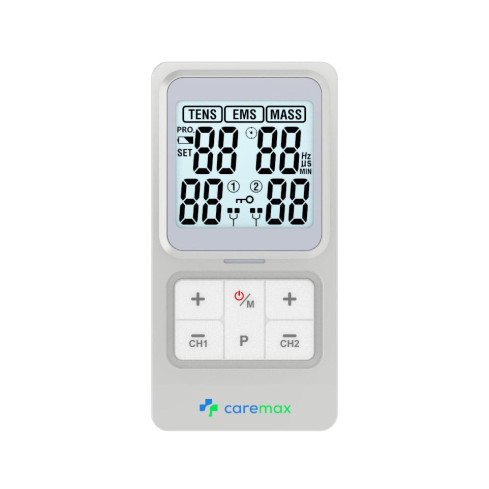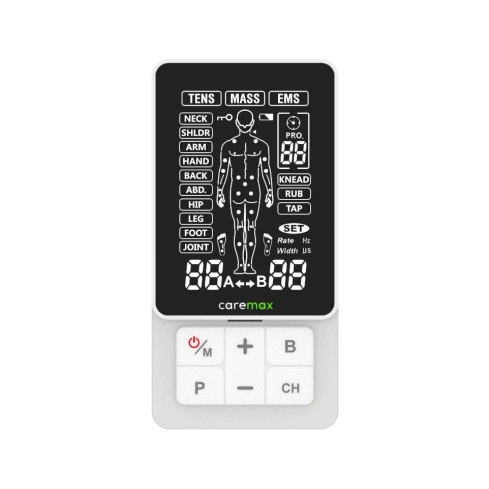Product added to cart
- Home
- TENS & EMS
- TENS Machine for Athletes & Sports Injury: How to use, Treatments and Benefits
TENS Machine for Athletes & Sports Injury: How to use, Treatments and Benefits
Using a TENS machine is a safe and effective way to relieve pain from a sports injury. Ranging from Achilles tendonitis to ankle sprains and lower back pain, it is a versatile and portable device to assist recovery. In fact, using a TENS machine can also potentially reduce inflammation, preserve muscle strength, and improve blood flow. The following article will discuss how to best use a TENS machine for sports injuries.
Common Types of Sports Injuries
Sports injuries encompass a range of conditions that commonly affect structures, such as connective tissue, fascia, muscle, bone, ligaments, tendons, cartilage, and other soft tissue. These structures can be affected in any number of joints and body regions, such as the:
- Head
- Temporomandibular joint (TMJ joint) or the jaw
- Neck
- Cervical spine
- Shoulder
- Mid-back or thoracic spine
- Elbow
- Wrist
- Hands
- Fingers
- Thumb
- Lower back or lumbar spine
- Pelvic girdle
- Hip joint
- Thigh
- Knee joint
- Ankle joint
- Foot
- Toes
According to the Australian Institute of Health and Welfare [1], around 22% of Australians have musculoskeletal injuries. This encompasses around 150 different types of physical conditions that are commonly seen by health professionals, including sprains, strains, fractures, subluxations, dislocations, arthritis, tendonitis, lacerations or cuts, and hemomatoma.
Specifically, the most frequently presented sports injuries include [2]:
- Ankle sprain
- Muscle strain (i.e., quadriceps, hamstrings, etc.)
- Back strain
- Dislocations and subluxations, particularly the shoulder joint
- Shoulder tendonitis
- Tennis elbow
What is a TENS machine, and how does a TENS machine work?
A TENS (Transcutaneous Electrical Nerve Stimulation) machine is a device that is used to help relieve both acute and chronic pain. For acute pain, a higher-frequency TENS setting helps stimulate sensory nerve fibres to inhibit nearby pain signals [3]. For chronic pain, a lower-frequency TENS setting will help stimulate the release of your body’s natural opioids, which help the body slowly combat pain [3].
Benefits of TENS Therapy for Sports Injuries
Those with sports injuries can benefit from using TENS therapy to assist with pain management and recovery. While more research [3] is still being established to discover further benefits of TENS therapy, there are some proposed benefits, including pain management, reduction of inflammation, muscle relaxation, improved circulation, and accelerated healing.
Pain Management
The most proven utility of TENS therapy is to reduce pain. According to a systematic review and meta-analysis of 381 studies, TENS therapy is both safe and effective for helping reduce both acute and chronic pain conditions [4]. By adjusting your TENS machine settings, you can preferentially reduce pain for acute (i.e., sprains, strains, etc.) and chronic (i.e., tendonitis, fasciopathies, etc.) sports injuries.
Inflammation Reduction
TENS therapy can help ease the symptoms of post-surgical pain and inflammatory conditions, including those related to sports injuries. These include conditions such as tendonitis (i.e., inflammation of the tendon) and arthropathies (i.e., conditions of the joints). A study by Chen et al. (2015) showed that using a TENS machine could reduce inflammatory cytokine release and substance P [5]. Inhibiting proteins, such as cytokines and substance P, can help reduce inflammation and ease pain.
Muscle Relaxation and Strength
At this stage, there is minimal research to suggest that TENS units affect muscle relaxation or strength. However, electrical muscle stimulation therapy (which is a setting found in EMS and TENS combined units) has been shown to preserve muscle mass and strength in ill hospital-bound patients [6]. Compared to no treatment, EMS may act as a potentially effective way to help sedentary and inactive individuals maintain their muscle strength.
Rehabilitation Support
A TENS unit can be a useful tool to support rehabilitation from sports injuries. Particularly in the earlier stages, where the affected area is inflamed and sore, the TENS machine can reduce pain to allow for rehabilitation movements.
For instance, early rehabilitation practices for a sprained ankle involve gentle range-of-motion exercises to assist with swelling management and restoring ankle mobility. In cases where the ankle is too sore, using a TENS machine can help with immediate pain relief to assist compliance with these types of rehabilitation exercises.
Additionally, using a TENS machine can also assist with pain relief during the early rehabilitation phases after surgery. Some sports injuries, such as ACL tears and fractures, may require surgery. Using a TENS machine can help with pain, particularly in the early stages after surgery. In a systematic review and meta-analysis by Bjordal et al. (2003) [7], they showed that using a TENS machine after surgery reduced the need to take pain medications.
Improved Circulation
Proper circulation of blood is crucial for recovery, health, and performance. While not the primary goal of using a TENS machine, it may also increase blood circulation to the targeted muscle(s). In a study by Sandberg et al. (2007), researchers found that low-frequency TENS increased blood flow to the targeted muscle [8]. Although this was not the case for high-frequency settings around 80 Hz, For improved circulation, you may consider using a lower frequency setting around 2 Hz instead.
Accelerated Return to Sport
More research is required to confirm that an accelerated return to sport from injury can be achieved by using a TENS machine. However, early pain relief is important for being able to participate in rehabilitation exercises. Neuromuscular benefits achieved from the adaptations gained from participating in rehabilitation can accelerate your ability to return to sports and athletic movement.
How to Use the TENS Machine for Sports Injuries
Using a TENS machine can vary depending on the type of sports injury that has been sustained. Under most circumstances, sports injuries can be separated into trauma and overuse injuries.
Traumatic sports injuries occur after the body has undergone trauma, such as a sprain or a strain. Under these circumstances, a TENS machine is particularly useful in the earlier, more painful, and swollen stages. There are a whole host of benefits for acute pain relief for traumatic injuries, such as early participation in rehabilitation, reduced need for pain relief medications, and ease of mind. For these types of injuries, higher frequency settings may be more effective in providing immediate and fast onset of pain relief (i.e., greater than 90 Hz) [3].
Overuse sports injuries occur after a period of training and insufficient recovery. This can lead to overuse injuries such as tendonitis, stress reactions, and bursitis. TENS machines can also help alleviate pain and allow for function and movement. For these types of injuries, lower-frequency settings may be more effective in providing long-lasting pain relief (2–5 Hz) [3].
Using Caremax TENS machine for Sports Injuries
We provide a comprehensive packaging solution for Recovery from Sports Injury. Discover the most sought-after products below essential for effective TENS & EMS therapy treatment.
 |
 |
| Caremax 2.0 Classic TENS machine | Caremax 2.0 Pro TENS Machine |
Where and when to not use TENS machines
While TENS machines are generally considered safe for managing sports injuries, it's essential to be cautious in specific scenarios and regions. Avoid using the TENS machine on compromised skin, such as [9]:
- Lacerations, wounds, or cuts
- Areas with altered sensations like tingling or reduced sensitivity
- Swollen regions, near cancerous or clot-prone areas,
- Regions of the body undergoing radiotherapy or radiation treatment
- Around critical arteries in the neck, especially the carotid area.
When considering electrode placement around the face or head, consulting a qualified health professional for guidance is advisable. Furthermore, certain individuals, such as pregnant women, those with implanted devices like pacemakers or neurostimulators, individuals with cognitive or mental challenges, and those unable to consent to treatment, should either refrain from using the TENS unit or seek advice from their GP beforehand [9].
Are there any risks of side effects when using a TENS machine in comparison to other methods?
Transcutaneous Electrical Nerve Stimulation (TENS) is widely used in sports injury management to alleviate pain by administering low-voltage electrical currents through electrodes. Despite its generally safe reputation, it's important to be aware of potential side effects [9].
When using the TENS for sports injuries, it’s important that it is properly applied and to seek medical attention if adverse reactions occur. Discontinuing treatment if any side effects manifest is crucial. Reported side effects include:
Commonly reported side effects:
- Skin irritation
- Unusual sensations around the treatment area
Less common side effects which typically occurs when used inappropriately or in unsafe areas. These include:
- Rashes
- Increased pain
- Seizures
- Disruptions to implanted medical devices
- Strokes
- Blood clots
- Skin damage
- Burns
Compared to other methods such as ice packs, heat packers, and massage guns, TENS machines are generally safe for most healthy people. If you are at a higher risk of side effects, please seek GP advice before use.
References
- Australian Institute of Health and Welfare. (2022). Musculoskeletal conditions in Australia: A snapshot (Cat. no. PHE 241; Arthritis series no. 25). https://www.aihw.gov.au/getmedia/e719c18d-d76d-46d2-b70a-a0b3c489afb4/aihw-phe-241.pdf.aspx?inline=true
- Royal Australian College of General Practitioners. (2010). Musculoskeletal injuries. https://www.racgp.org.au/getattachment/ff7e9d68-da08-4eb2-a6fc-3b5bcb21406a/Musculoskeletal-injuries.aspx
- Watson, T. (2017). Transcutaneous Electrical Nerve Stimulation. Worldwide Military Sports Medicine, 11(4). https://web.archive.org/web/20170809062344id_/https://www.wwmsi.com/documents/WWMSI_Transcutaneous_Electrical_Nerve_Stimulation_Tim_Watson.pdf
- Johnson, M. I., Paley, C. A., Jones, G., Mulvey, M. R., & Wittkopf, P. G. (2022). Efficacy and safety of transcutaneous electrical nerve stimulation (TENS) for acute and chronic pain in adults: A systematic review and meta-analysis of 381 studies (the meta-TENS study). BMJ open, 12(2), e051073.
- Shin, D. D., & Sharan, A. D. (2022). Electrical Muscle Stimulation in the Intensive Care Unit. Critical Care Medicine, 41(10), e477. https://journals.lww.com/ccmjournal/abstract/2013/10000/electrical_muscle_stimulation_in_the_intensive.17.aspx
- McGuiness, K. R. (2014). Clinical Guidelines for the Use of Transcutaneous Electrical Nerve Stimulation in Physical Therapy. Physical Therapy, 95(1), 76-85. https://academic.oup.com/ptj/article/95/1/76/2686475
- Smith, J. K., & Johnson, L. M. (2007). Transcutaneous electrical nerve stimulation for chronic pain: A survey of current practice by physical therapists in Georgia. Physical Therapy, 87(8), 1047-1057. https://academic.oup.com/ptj/article/87/8/1047/2742270
- Sandberg, M. L., Sandberg, M. K., & Dahl, J. (2007). Blood flow changes in the trapezius muscle and overlying skin following transcutaneous electrical nerve stimulation. Physical therapy, 87(8), 1047-1055.
- Boardman, L. A., & Long, J. A. (2018). Contraindications and precautions for the use of transcutaneous electrical nerve stimulation (TENS) in pain management. University of Iowa Hospitals and Clinics. Retrieved from https://www.healthcare.uiowa.edu/marcom/uihc/pain_medicine/contraindication_precautions_best062018.pdf
Categories
- TENS & EMS (19)
- Latest News (41)
- Massager (2)
- Nebuliser (8)
- Skin Care (3)
- Period Pain Management (1)
- Fitness (2)